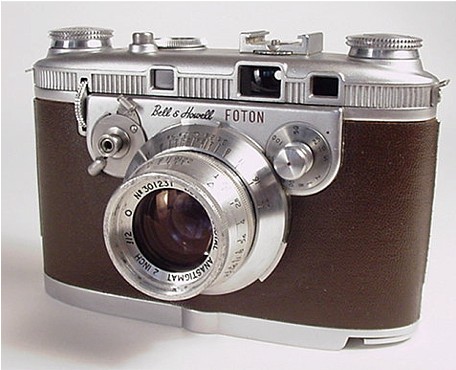
Bell & Howell Foton

The Bell & Howell Foton was an ambitious attempt by an American camera manufacturer to create a world-class 35mm still camera. The Foton, introduced in 1948, was the first still camera manufactured by Bell & Howell. Bell & Howell literature states that development of the Foton spanned over ten years and cost over one million dollars.
The first Bell & Howell cine camera was launched in 1912. Over the years Bell & Howell established a reputation for building rugged professional and amateur spring-motor drive cine cameras. Because of their extensive cine camera knowledge, it makes sense that Bell & Howell decided to enter the still market with a niche product, a spring-motor drive automatic advance camera.
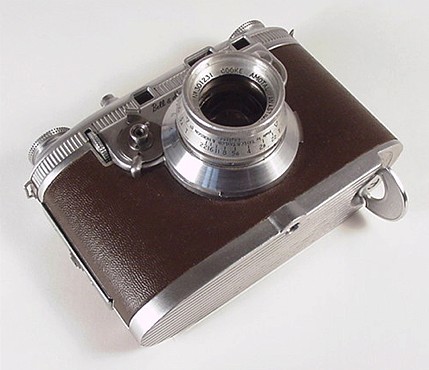
The spring motor winding key can be seen unfolded from the camera baseplate. Also on the baseplate, centered below the lens and positioned far forward, is a tripod socket. The tripod socket's unusual forward position was probably intended to provide better balance for the massive 4 and 12 inch accessory lenses.
It is interesting that a wide-angle lens was not offered for this full-frame 35mm camera. With its greater depth-of-field, a wide-angle lens would be suitable for following certain types of action. The lens could be preset to its hyperfocal distance and the photographer would be freed to concentrate on following the subject in the viewfinder.
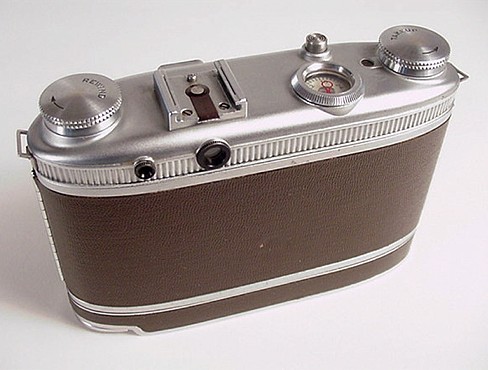
The Foton's view and rangefinder are not combined. The rangefinder eyepiece is located on the left, and the viewfinder eyepiece is on the right.
This view of the camera's top plate shows the rewind knob located on the far left. To its right is the accessory shoe with hot-shoe flash connector.
The large circle to the right of the accessory shoe is the frame counter. It has a knurled bezel with glass cover plate and red pointer. Frame markings running from 0 to 36 appear on a dial located below the glass window. This is a manual-reset frame counter. When loading a new roll of film, the bezel needs to be rotated to align the pointer to the 0 mark. The frame counter design is unusual - possibly unique among still cameras, and classy. The frame counter mechanism is well sealed from dirt and easy to read.
The round knob in front of the frame counter is the film rewind button. Another unusual location.
The large knob on the far right is the wind, or takeup knob. Now why would an automatic advance camera need a takeup knob? It is used when loading film, and also to wind film to the next frame when the spring motor can't. This can happen when the spring motor becomes wound down and does not have enough power to fully advance the film.
There is a small round window to the left of the takeup knob. This is the film advance indicator. It tells whether or not the film was fully advanced after exposure.
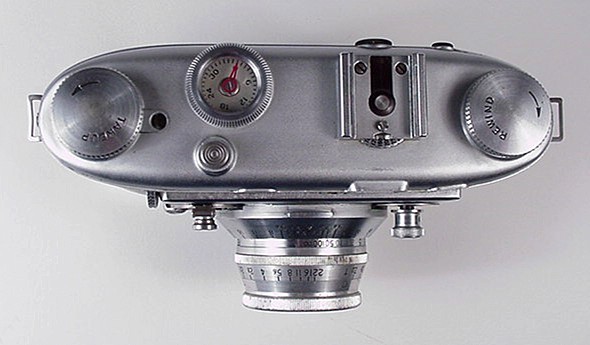
Notice a small semi-circular wheel at the front of the accessory shoe. This is a film speed reminder dial.
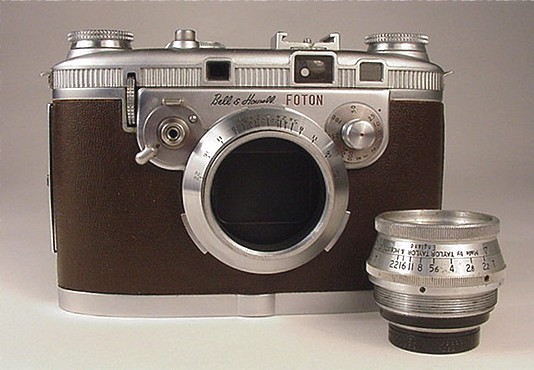
The normal lens, manufactured by Taylor, Taylor & Hobson Ltd., England is a coated 2 inch f/2.0 Cooke Amotol Anastigmat. Given its cine camera background, Bell & Howell opted to calibrate the lens in T-stops rather than f-stops. The lens' maximum T-stop aperture is 2.2.
The T-stop system, to this day, is universally employed in commercial cinematography. The advantage of using the T-stop system is of minor importance to the still photographer, but it does provide more consistent exposures over the f-stop system when switching lenses and focal lengths.
T-stops are a measurement of the actual light transmission qualities of a lens; f-stops are a mathematical ratio of lens diameter to focal length. The Foton may have been (were there others?) the only still camera ever made to offer T-stop lenses. Bell & Howell believed T-stops would provide a level of precision previously not offered to still photographers, and pitched this precision as an advantage in color photography due to color film's lack of latitude. But history has shown the public did not embrace this point of view.
The standard 2 inch focal length lens has a screw-thread mount. Foton telephoto lenses bayonet onto the three lugs seen surrounding the camera lens mount. As with Contax and Nikon rangefinder cameras, the focusing gears for the normal lens are built into the camera body. Focus can be adjusted by turning the lens, or by turning a knurled wheel on the camera front.
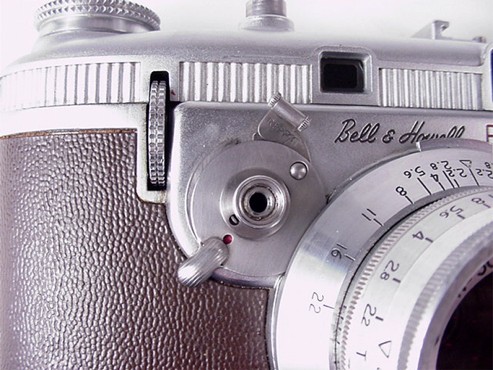
The focusing wheel can be seen protruding from the camera front. Whether adjusting focus by turning this wheel or by rotating the lens, focus is very smooth.
Between the wheel and lens is the shutter release button. It is threaded to accept a standard cable release.
Surrounding the shutter release are two control levers. The lower lever is the shutter release lock. The red dot above the locking lever indicates the release is unlocked.
The top lever, shown in its outward position, switches the film advance between single and repeat exposure modes. In single mode, each time the shutter release is pressed, the shutter fires and film advances one frame. In repeat mode, the shutter fires and film advances continuously, advertised at an incredible 4 - 6 frames per second. That is a fast repeat rate for a full-frame 35mm camera, even by today's standards. The Foton can shoot between 10 and 15 consecutive exposures with the spring motor fully wound.
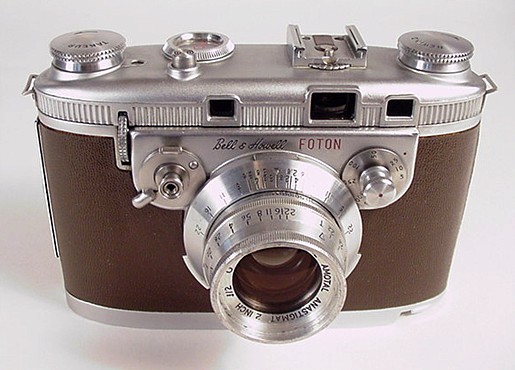
The Foton is generally considered a marketing failure. The Foton was available for just a few years and not many were sold. This is unfortunate, because Bell & Howell created a jewel of a camera. When introduced, the Foton's retail price was 700 US dollars and in addition, a 100 dollar excise tax applied. Due to slow sales the price was soon dropped to 500 dollars.
Pricing is the reason usually given for the Foton's failure. I agree that pricing killed the Foton, but it was not the only factor. I think Bell & Howell misjudged the customer price/performance profile in the Foton's niche market. Perhaps they thought that by building a model far more advanced than their competition, customers would be willing to pay a premium. Because the Foton is a focal-plane shutter, coupled-rangefinder 35mm camera, one might assume its competition was the Leica, a feature-rich and expensive camera with a relatively large market. But the Foton's competitor was not E. Leitz.
The Foton's only competition was with one camera model sold by one company. The Foton design technically blew the competition away, but the cost of its advanced features - coupled rangefinder, repetitive motor-drive and full-frame format priced the Foton far above its competitor. So yes, pricing killed the Foton, but were it not over-designed in its first incarnation, it might have achieved a foothold. Later Bell & Howell could have followed-on with an advanced model. This is in fact, what its competition did.
In my opinion, there was nothing technically wrong with the Foton. The camera in my collection works perfectly. Controls are smooth, there are no shutter problems, the finders are clear and bright and the motor is strong as an ox. Materials and finish were well chosen, showing very little wear for a camera over 50 years old. Bell & Howell obviously believed in the quality of this camera, because it was sold with a lifetime warranty covering both parts and labor.
The Foton, considered by many collectors as a premier American 35mm camera, is often compared to Leica cameras of its day. At the time, Leica cameras epitomized quality in a 35mm camera, and justifiably so. But to compare the Foton to a Leica seems odd to me. I guess the thinking goes that if the Foton was at least of equal quality, with similar features, then it should have attracted plenty of buyers. If the camera was not a good seller then the price must have been too high. But I believe the Foton and Leica addressed different markets. Given a difference in markets, price comparisons are tricky. If the Foton could do a specific job well (rapid-advance action photography), that was not feasible with a Leica, and if demand for rapid-advance cameras was sufficient, then the Foton might have succeeded even with a higher selling price.
A comparison of the Foton to the Leica IIIf shows that on a features basis, the two cameras are very similar. The most remarkable difference is that the Foton has a high speed motor drive. There are also a few minor differences. The Foton has a durable metal focal plane shutter vs. the Leica's cloth focal plane shutter. The Foton has a flash hot-shoe, the Leica does not. A quality comparison indicates both cameras are rugged and precise, well engineered and built to very high standards. A usability comparison reveals the Foton to be heavier, larger and noisier than the light, compact and ultra-quiet Leica. The Foton is quick to load due to its hinged back vs. the Leica's removable baseplate.
It is important to note that the Foton was engineered from the ground up, as were say, later Nikon cameras, to withstand the punishment of a hard-driving relentless motor drive. The Leica screw-mount models were not capable of being driven so hard.
Leitz sold the Leicavit, a rapid-wind baseplate accessory for the IIIf, however this manual-wind accessory could not come close to matching the Foton's 6 frames-per-second motor drive. A limited production spring motor accessory was also available for the model IIIc, and would probably work on a Leica IIIf, though this combination was not marketed by Leitz. So, when the Foton was introduced, Leitz did not sell a comparable rapid-advance competitor to the Foton.
The Foton shutter was extremely noisy for a rangefinder camera. Some modern single-lens-reflex cameras are quieter. I think the Foton would otherwise be an excellent wildlife camera, but it makes too much racket to be unobtrusive. The Leica's whisper quiet shutter is ideal for wildlife photography.
The Leica and Foton targeted different market segments. A Leica would be chosen by professional photographers and financially comfortable amateurs who wanted a reliable, compact, precise, quiet, system camera with exceptional lenses and a variety of accessories. Speed of operation was not a strong Leica selling point. The Foton would be chosen by professional photographers and wealthy amateurs who needed a reliable rapid-advance camera. The Foton's customers would mainly be sports photographers. The Foton's noisy mechanism must have been a factor in limiting its wider application to other fields of photography.
I have to believe that Bell & Howell knew their competitors were not Leitz, Zeiss or other manufacturers of professional-quality 35mm full-frame rangefinder cameras. I doubt they thought the public would pay an exorbitant premium for high-speed automatic film advance. The average photographer did not need it, nor would they find the Foton's extra weight, bulk and noise level acceptable.
The Foton's only competition came from Otto Berning's Robot cameras. Otto Berning of Dusseldorf, Germany had been making spring-motor rapid advance cameras since 1934. The Robot II model, introduced in 1939 and available until 1951, was the Foton's direct competition in this niche market. Berning was a successful manufacturer specializing strictly in rapid-advance cameras. They knew the business. They built the market.
Perhaps Bell & Howell decided the way to beat Berning at their own game, which Berning controlled since the 1930s, was to build a camera not only of the highest quality, but with advanced features as well.
If one were simply to compare specifications, the Foton is the hands-down winner. The Robot II film format was 24mm x 24mm, whereas the Foton's measured 24mm x 36mm, the standard 35mm full-frame image size.
The Robot II required film to be pre-loaded, by the photographer, into special Robot cassettes. The Foton accepted standard 35mm cassettes. Around 1951 an updated Robot II model, the Robot IIa was introduced. The IIa accepted standard 35mm cassettes, possibly as a response to Foton competition.
The Robot II shutter did not offer a 1 second speed, but are slow speeds really important in a rapid-advance camera?
The Foton offered a coupled rangefinder. The Robot did not have a rangefinder. Berning believed adequate focus was achieved by using zone focusing and their lenses were marked to facilitate this. Also, the Robot normal lenses were slightly wide (wide-angle) compared to the 2 inch Foton lens. Thus they gave somewhat greater depth-of-field.
The Foton motor-drive had a repeat mode, the Robot II had only single-shot capability. It has been reported that with the Robot, an experienced photographer could fire 5 frames per second. I am dubious. I can imagine pressing the release twice per second, but am skeptical of a faster rate. I also imagine that unless the camera is supported on a sturdy tripod, pressing the release so quickly would result in camera shake.
The Robot II offered a slightly larger range of interchangeable lenses, of Zeiss and Schneider manufacture, including wide-angle lenses not available on the Foton, and a greater number of accessories. The Robot II was much smaller, lighter and quieter than the Foton.
If you were a photographer shopping for a rapid-advance action camera in 1951, which camera would you choose? The Foton? But could you afford it? In the USA of 1951, you could buy a new Ford automobile for around 1300 US dollars. You could purchase a new Foton for 498 dollars (original price 700 dollars, ca 1948). A Leica IIIf with f 2.0 Summitar lens listed for 385 dollars, but it was not a rapid-advance camera, or you could buy the Otto Berning Robot II camera with a Schneider Xenon f 1.9 lens for 207 dollars. If you were looking to save some money, you could pickup a new Robot II with a Schneider Xenar f 2.8 lens for 155 dollars.
Most likely over-design and poor market research. Too bad. A less ambitious design might have ensured longevity for Bell & Howell in the professional still camera market. How interesting that just a few years after the Foton's demise, Otto Berning introduced the Robot Royal 36 model, a full-frame rapid-advance motor drive camera with coupled rangefinder and specifications very similar to the defunct Foton. The Robot Royal 36 enjoyed a long life, selling for an enviable 15 years.

|
Page created February 12, 2002;
updated December 20, 2020 |